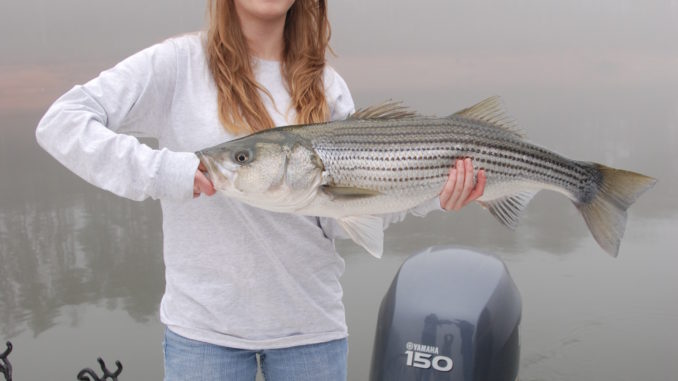
Keep an eye on the birds; they’ll lead you to schooling fish every time.
“What will February bring?”
Many anglers ask that question as Old Man Winter decides how he’s going to behave in South Carolina. For the past two years, he has granted us a pass, with relatively mild temperatures.
As a result, fishermen who target striped bass, particularly those who love the run-and-gun tactics used to chase schooling fish, have had good seasons when water temperatures that didn’t bottom out. The fish remained active and pods fed on roaming schools of threadfin shad all winter.
Even fishermen who mostly fish live bait for stripers make it a practice to keep a couple of rods rigged with lures in the event the surface waters around them begin to boil. Other anglers practice bird-watching, keeping an eye to the sky for seagulls and shorebirds to alert them to the action.
Regardless of your approach, the sight of gulls wheeling over water churning with hungry striped bass is the kind of stuff anglers dream about. February is one of the better times of year to get in on this action, which is common on several reservoirs around South Carolina.
Preston Harden of Bucktail Guide Service said he’ll remember the winter of 2012 fondly, because water temperatures on Lake Hartwell never fell below 50 degrees. Hartwell stripers and hybrids stayed active all winter, and Harden and his clients took advantage.
“In a normal year, a good schooling bite starts sometime about the first of December and goes into February, but it’s weather-dependent. When I see the water temperatures between about 47 and 57, that’s when they’re real active,” said Harden (706-255-5622).
With water levels dropping well below normal, many anglers avoid Hartwell because they think the low water hurts the bite. Harden said he has not found that to be the case.
“In low water, I don’t see the fishing slow down,” he said. “There might be a problem when you hook a big fish; if he doesn’t run across the surface and stay shallow, he’ll run down and try to break you off, and the trees aren’t as deep now.
“The biggest problem I see is anglers throwing baits that are too big, especially those Alabama rigs. I saw a hundred people throwing an Alabama rig last year. I never saw but maybe one person catch a striper on one. Fish are feeding on little threadfin shad; that’s why I try to match the bait with a 1/4- or 1/8-ounce bucktail jig paired with a little soft plastic on it.”
Harden said fish are likely to school anywhere , but has certain places that he likes to check and usually has no problem getting on the fish.
“I look for schooling stripers up the Seneca, up the Tugaloo and in the major creeks. Last winter, they never really went in the smaller creeks; they stayed in the river channels — in the Tugaloo up towards (Interstate) 85 and in the Seneca up toward Coneross and around Red Banks near Clemson,” he said. “You really just got to ride until you find the birds. Just finding birds doesn’t mean there are actually fish — and they’re not always active on the surface — but if you find a whole bunch of birds, diving repeatedly into a small area, it’s almost guaranteed there are fish around there, because the birds are working the same baitfish those fish are.”
On Clarks Hill Lake, Brad Sasser of Sasser’s Guide Service spends much of February in pursuit of striped bass in the areas of Benningsfield, Hawe, Wells and Dordon creeks on the South Carolina side of the lake and Amity and Germany creeks on the Georgia/Little River side. Sasser prefers to tempt both hybrids and stripers with live baits, but he will come rigged to cast artificials if the opportunity arises.
“If you’re live-bait fishing, you want to put your planer boards out way before you get to the school of fish and just drag your planer boards through the outskirts of the school. Make a pass back and forth a couple of times, catching each side of the school,” said Sasser (706-589-5468). “The biggest problem we have here is when bass-boat fisherman want to run full speed into the schools with their big motor and then kick the trolling motor out that last minute.”
Sasser said that if anglers in separate boats will work together and show some mutual courtesy, there no reason not to have surface activity for extended periods of time.
“Stripers will come up and stay for long periods of time as long as you leave them alone,” Sasser said. “If you can fish that school without breaking up the bait, the school will hold together a significant amount of time. It’s just a matter of taking proper precautions not to spook the bait, because once you disturb that bait, you’ve killed the school.”
As a guide, Sasser likes to find schooling fish because his clients get a lot of action on “party fish” that range anywhere between two and eight pounds. He said that schooling fish usually draw bigger fish to the area, but those fish hold in distinctly different patterns.
“You need to get further back in the creeks if you want to find larger stripers waiting on the bait to come to them,” he said. “The bigger fish are lazier, and they’re smarter. They wait for the smaller fish to bust the bait up and drop it down to them, or they wait for them to chase that bait back to shallow water. To catch the larger stripers, you need to get back there with planer boards and fish the back parts of the creeks using a larger bait.”
Laurens County’s Chris Palmer frequently fishes Lake Greenwood for schooling stripers in February; he said the key to catching schooling fish is to be in the vicinity when the fish surface while feeding on shad.
“Threadfin and gizzard shad are the primary baitfish in Greenwood,” Palmer said. “Stripers will usually try to corral baitfish in deep water and push them to the surface over humps or long points.”
Locating the fish in deep water first helps put fishermen in the right area. Of course, if you find stripers hanging out in or on the edge of deep water, Palmer advises trying to catch a few deep fish before the schooling activity begins. To do so, he relies on heavy lead baits such as bucktail jigs, jigging spoons or The Pro Shad Spin, a jighead/spinner combo made locallly.
Palmer starts his search for deep-water stripers around humps and points across from Lake Greenwood State Park. Mud Island is one of his favorites, especially when low water turn the island into an extended long point.
“There may be a few birds working the area, even this late in the year, and that’s a sure sign that stripers are getting ready to come up” he said.
Palmer admits that Greenwood stripers may not run as large as stripers from other state lakes, and he compensates by downsizing his tackle to match the fish.
“Most stripers that come out of Greenwood will be in the 3- to 5-pound range,” he said. “For these fish, I like to use 10- to 12-pound test line spooled on either an Abu Garcia 5500 baitcast reel or a medium-action spinning rod combo.”
This typical bass tackle makes great sport of the average-sized Greenwood fish but still has enough backbone to handle the occasional 12- to 15-pound striper that shows up.
If the fish around the dam won’t cooperate, Palmer will move up the lake and target long stretches of the main-river channel, particularly the area between the 221/72 bridge and the upper railroad trestle. These fish often suspend over the main channel and are quick to nail a big topwater bait, a heavy jig or Pro Shad Spin fished vertically along the channel edge.
When Dale Gossett of Palmetto Striper Guide Service in Gilbert targets stripers on Lake Murray, he’s normally uses live bait, but he’s not immune to the symphony of gulls crying while they’re flying recon over an area as striped bass church the surface.
When he decides to play run-and-gun, it’s typically using a bucktail jig with an ice fly trailer — something of a traditional bait on Murray.
“It’s just a little, small, shiny looking metal spoon with a fairly light hook soldered to it and usually a little bit of hair tied to the hook,” said Gossett (803-318-3911). “It’s fished as a trailer tied pretty close, like six or eight inches behind the jig. The fish usually hit it on the fall because it wobbles when it falls.”
Gossett finds most of his fish on the upper section of Lake Murray. Like most other anglers he’s got an eye peeled for bird activity. Seagulls, terns and other coastal birds move inland during the winter to feed on schools of shad.
“In winter, I fish the top end of the lake, I’d say probably from Elbow Bend up. Spinner’s Landing is in Elbow Bend, and I start from there,” Gossett said. “Because I’m moving — running and gunning — I’m chasing birds, and I’ll cast to the school once I see them come up. I keep a good casting rod, something I’m comfortable throwing, rigged and ready.”
Gossett is a fan of bigger live baits and smaller artificial baits in the winter. He concentrates his running and gunning to major points in the areas he’s described but will break off that pattern when fishing live bait.
“You want to pull a pretty big bait because they stay live longer,” he said. “A small bait will die on you pretty quick. You don’t have to stay in deeper water like you would when chasing schooling fish. With live bait, fish will run right up on a shoal, but usually, they want a creek close by so they can run into if they need to.”
Birds are even more important on Lake Moultrie, according to guide Truman Lyon of Santee Cooper Charters, because “everything looks the same” on the bowl-shaped lake.
“I’m just watching for birds, watching for bird activity and drifting live bait,” said Lyon (843-729-2212). “Certain areas of the lake, where there are humps that I’ve been fishing for years, typically hold fish. I normally drift over these humps with live bait while I watch for schools.”
While other venues may be still in the grips of winter inlate February, the emergence of early spawning activity is noticeable on Moultrie. This is partially due to the warmer climate and partially to the long distances striped bass have to travel through the Santee system before they actually spawn.
“In mid-February, they start moving,” Lyon said. “Most of the fish start moving toward the mouth of the Diversion Canal to stage before heading up. Spawning fish, the bigger fish, will then start moving out. They move through the canal, make their way up through the upper lake and migrate up towards Columbia.”
DESTINATION INFORMATION
HOW TO GET THERE: For a complete listing of public boat launches on Lakes Hartwell, Clarks Hill, Greenwood, Murray, Moultrie and other impoundments in South Carolina, the SCDNR website hosts a listing of all locations catalogued both by county and by lake. This listing can be found at www.dnr.sc.gov/mlands/boatramp/
BEST TACTICS: The best way to find schooling striped bass below the surface is to watch for bird activity above it. Some anglers choose to use one rod and run-and-gun from one location to the next, while others may fish live bait in the general vicinity while waiting for the fish and bait to come to the surface.Any artificial bait that can be cast a long distance will work to catch schooling fish. It’s typically best to match the size of your bait with the size of the bait. Most anglers err by using too big a bait when a smaller bait may work better. Size can also be judged by the aggressiveness of the fish; large, aggressive schools will hit most anything, any size bait that makes a commotion, while smaller schools are better worked with a smaller bait that provides more intense action as it falls.
FISHING INFO/GUIDES: Lake Hartwell: Preston Harden, Bucktail Guide Service, 706-255-5622, www.bucktailguideservice.com; Clarks Hill: Brad Sasser, Sasser’s Guide Service, 706-589-5468, www.williamsasserfishing.com; Lake Murray: Dale Gossett, Palmetto Striper Guide Service, 803-318-3911, www.palmettostriperguide.com; Lake Moultrie: Truman Lyon, Santee Cooper Charters, 843-729-2212, www.santeecoopercharters.com. See also Guides & Charters in Classifieds.
ACCOMMODATIONS: Anderson Convention and Tourism Bureau, 877-282-4650, www.visitanderson.com; Lake Murray Country, 866-SCJEWEL or www.lakemurraycountry.com; Greenwood Regional Tourism and Visitors Bureau, 864-953-2466, www.visitgreenwoods.com; Santee Cooper Country, 803-854-2131, www.santeecoopercountry.org.
MAPS: Navionics Electronic Charts, 6 Thatcher Lane, Wareham, MA 02571; delorme South Carolina or Georgia Atlas & Gazetteer, 800-561-5105, www.delorme.com; Fishing Hot Spots, 800-ALLMAPS, www.fishinghotspots.com.

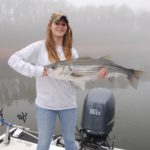
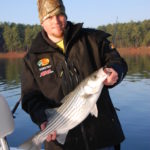
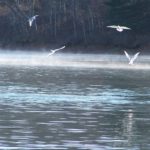
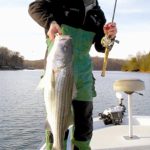
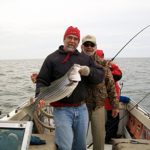
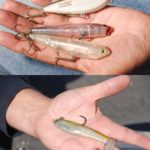



Be the first to comment